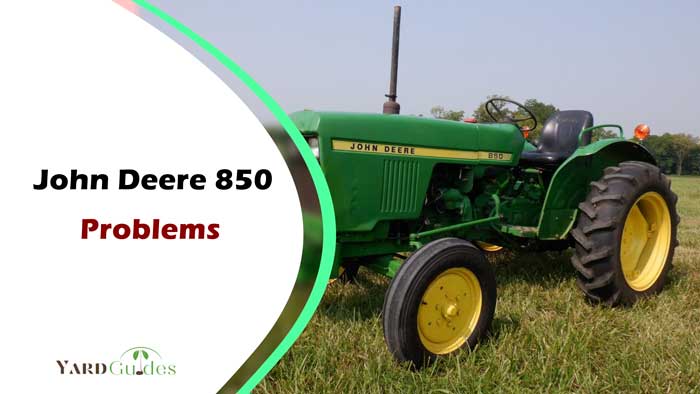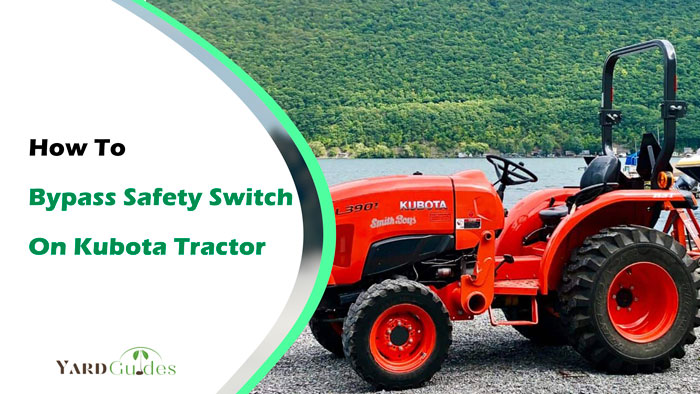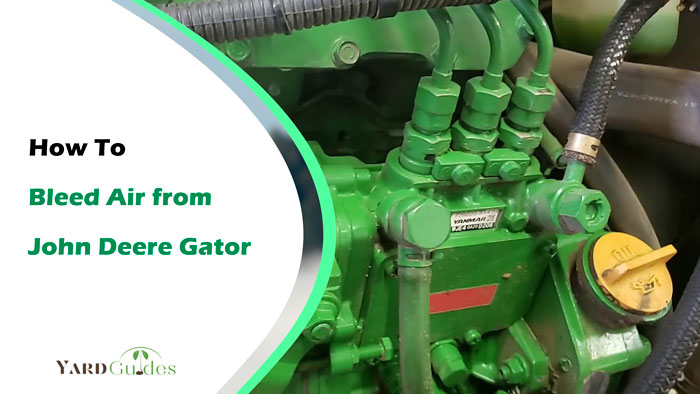The John Deere 850 is a reliable tractor powered by the Yanmar 3T80-J diesel engine. As such, it can generate up to 25 horsepower and 850 pounds-feet of torque. However, this tractor is prone to several problems. So, what are the most common John Deere 850 problems? They include the following:
- Gear/clutch issues
- Malfunctioning hydraulic system
- Starting difficulties
- Overheating issues
- Steering problems
- Electrical issues
But how do you fix all these problems? Stay here to learn more about the JD 850 issues and how to affix them.
Common Issues With the John Deere 850 Tractor & Fixes Table
Check out the table below summarizing the common John Deere 850 tractor problems and their possible solutions.
| No. | Problems | Possible Fixes |
| 1. | Gear/Clutch Issues | Adjust the clutch linkage to the correct specs. |
| Replace the transmission clutch. | ||
| 2. | Malfunctioning Hydraulic System | Change hydraulic oil and filter. |
| Replace the rockshaft piston seals and gaskets. | ||
| Install new hydraulic control valve. | ||
| 3. | Starting Difficulties | Bleed the fuel system. |
| Clean the battery terminal connections. | ||
| Clean the fuel lines. | ||
| 4. | Overheating Issues | Replace the head gasket. |
| Replace the water pump impeller. | ||
| 5. | Steering Problems | Adjust the toe out. |
| Tighten the tie rods. | ||
| Replace the steering gear box. | ||
| 6. | Electrical Issues | Replace any blown fuses. |
| Change the starter solenoid. | ||
| Install new alternator. |
What Are The Common John Deere 850 Problems?
Like with other tractor models and brands, the JD 850 is susceptible to various problems that include the following:
1. Gear/Clutch Issues
Over time, your JD 850 may fail to drive in high gear but only operate in low-speed first gear. Sometimes, the tractor may refuse to move in any gears, including the high and low range.
In some cases, the tractor may also pop out of gear, especially when going down or pulling hard up a hill. Mostly, it is notorious for jumping out of the 3rd and 1st gears. Generally, these gear problems occur due to a bad clutch or a misaligned clutch linkage.
Solution 1: Adjust the Clutch Linkage
First, you should check if the clutch linkage is adjusted to the recommended specs as per the manual. If not, adjust the link, ensuring you have around a half-inch clutch pedal travel. You simply push the linkage away from the clutch fork, ensuring there is some free travel between the two.
Solution 2: Replace the Clutch
Another way to fix the problem is to replace the transmission clutch. Here are steps on how to do it:
Step 1: Split the Tractor Apart
First, pull the loader off, the fenders, and the floorboards. After that, unhook the hydraulic lines, the clutch linkages, fuel lines, and any wiring connecting on both sides of the tractor. Then, separate your tractor at the clutch housing. Make sure to use floor jacks or solid stands to support the two tractor halves.
Step 2: Locate the Clutch
Next, locate the transmission clutch, which sits between two pressure plates on the rear of the first half. Next, unscrew the pressure plates’ bolts to expose the clutch. Then, remove the clutch.
Step 3: Install New Clutch
Slide your new clutch onto the shaft. And using a clutch adjusting tool, ensure the clutch is aligned correctly. Then, tighten the bolts securing the clutch to the plates. Lastly, reassemble your JD 850 tractor and test the clutch to see if it’s working.
2. Hydraulic System Malfunctioning
The hydraulics of the John Deere 850 are highly prone to failure. Sometimes, the hydraulics, including the front loader and bush hog, may barely work in cold weather. This happens even after warming up for a long time.
In other cases, the bucket and the three-point hitch may fail to work entirely or sink slowly when the engine is off. Besides dirty hydraulic oil and filter, a bad hydraulic control valve and worn-out rockshaft piston seals or gaskets could cause this problem.
Solution 1: Change the Hydraulic Filter and Oil
First, you must change the hydraulic oil and filter if it is dirty or contaminated with water. Here is how to do it:
- Step 1: Remove the drain plug to drain the oil.
- Step 2: Take apart the screen cover by unscrewing the bolts.
- Step 3: Clean the screen or replace it if it is damaged.
- Step 4: Remove the hydraulic filter located near the brake pedals under one of the footboards.
- Step 5: Install the new filter.
- Step 6: Refill the oil.
Solution 2: Replace the Rockshaft Piston
Next, check the seals on the rockshaft piston. They are responsible for activating the 3-point hitch. If the seals are leaking, they can lead to low hydraulic pressure. In this case, you need to replace the rockshaft piston and here is how to do it.
- Step 1: Drain all the hydraulic fluid.
- Step 2: Locate the rockshaft piston at the rear of the tractor beneath the seat.
- Step 3: Take apart the rockshaft cover.
- Step 4: Remove the rockshaft piston, including the seals.
- Step 5: Install new seals, O-rings, and gaskets.
- Step 6: Reinstall the rockshaft piston into the hydraulic system.
Solution 3: Replace the Hydraulic Control Valve
Another solution would be to replace the hydraulic control valve. Below is a step-by-step guide on how to do this:
- Step 1: Disconnect the drain plug and empty all the hydraulic fluid.
- Step 2: Remove the seat, fender deck, and any hydraulic system parts blocking your access to the control valve.
- Step 3: Remove all components attached to the valve, including hoses and wiring.
- Step 4: Unscrew the bolts securing the valve in place and remove the valve.
- Step 5: Install the new hydraulic control valve and reconnect all the components you had removed.
- Step 6: Refill the hydraulic fluid to the correct levels.
3. Starting Problems
With JD 850 tractors, they may fail to start even with a new and fully charged battery. This problem may be accompanied by a faint clicking sound when you turn the key.
Sometimes, the tractor may crank fine but fail to fire up even after changing the fuel filter and adding new oil. Often, this problem occurs when the tractor runs out of fuel entirely. Apart from build-up around the battery connections, blocked fuel lines could cause starting problems.
Solution 1: Bleed the Fuel System
If your tractor runs out of fuel and has starting issues, you must bleed the fuel system. Here is how to do it:
- Step 1: Fill the tank with fuel.
- Step 2: Locate the two screws at the top of the fuel filter.
- Step 3: Unfasten the left screw and allow the fuel to drain before tightening it back.
- Step 4: Repeat the same with the right side screw.
- Step 5: Remove the bleeder screw on the injection pump along the fuel line, allowing all the air bubbles to come out. Tighten it back and start your tractor.
Solution 2: Remove Corrosion on Battery Connections
Another solution would be to take off the battery terminal connections to remove any corrosion. Then, coat them with baking soda and sprinkle small amounts of water on each terminal. Next, use a toothbrush to scrub them.
Solution 3: Clean the Fuel Lines
When the fuel lines are clogged and causing the starting issues, you must clean them, and here is how to do it.
- Step 1: Remove all the injector lines between the injectors and the pump.
- Step 2: Clean the lines with compressed air.
- Step 3: Remove the fuel pump fittings and clean the tank with fresh fuel.
- Step 4: Reinstall everything and bleed the fuel system.
4. Overheating Issues
Another common issue is the tractor overheating. Unfortunately, this problem may occur even after topping the coolant to the correct levels and replacing the thermostat. Also, the tractor may overheat even after cleaning the radiator and flushing the cooling system.
In most cases, the overheating issues in JD 850 tractors are due to a blown head gasket or worn-out water pump impeller.
Solution 1: Replace the Head Gasket
Below is a step-by-step guide on replacing your JD 850’s head gasket if blown.
- Step 1: Disassemble the engine cylinder head, including everything that attaches to it, like oil lines and radiator hoses.
- Step 2: Remove the head gasket by unscrewing the head bolts.
- Step 3: Clean any remains of the gasket on the surfaces of the engine head.
- Step 4: Position the new gasket over the cylinder head. Ensure the holes in the gasket perfectly line up with the holes in the engine block.
- Step 5: Fasten the cylinder head bolts to secure the head gasket. Make sure not to over-torque the bolts.
- Step 6: Reassemble the engine cylinder head and all other components you may have disconnected.
Solution 2: Replace the Water Pump Impeller
If the water pump impeller is worn-out, you must replace it, and here is how to do it:
- Step 1: Locate the water pump and remove all the components blocking your access to the pump.
- Step 2: Drain the coolant.
- Step 3: Unscrew the bolts attaching the water pump to the engine block and remove the pump.
- Step 4: Locate the impeller inside the water pump and remove it.
- Step 5: Position the new impeller onto the water pump.
- Step 6: Reinstall the water pump and reattach all parts you disconnected.
- Step 7: Refill the coolant to the correct levels.
5. Steering Problems
The John Deere 850 steering has a tendency to wobble. Although not very noticeable, the steering wheel may move side to side about 4 to 5 inches. When this happens, the steering rods and front wheels may also move sideways independently.
Some causes of steering issues are loose tie rods, tires having too much toe in, and a defective steering box.
Solution 1: Adjust the Toe Out
One thing you could do to fix the steering problems is to ‘toe out the front tires. Simply tilt the tires about a 1/4” away from each other to increase oversteer.
Solution 2: Tighten the Steering Tie Rods
If the steering tie rods on the front axle of your JD 850 move way too easily, you must retighten it. Simply use a torque wrench to tighten the lock nuts on the rods to the manufacturer’s specifications.
Solution 3: Replace the Steering GearBox
Over time, the steering gearbox may wear out, requiring a replacement. Here is how to replace it.
- Step 1: Locate the steering gearbox and disconnect the steering linkage.
- Step 2: Uninstall the pitman arm from the steering box.
- Step 3: Remove the steering shaft and power steering lines from the box and drain the hydraulic fluid.
- Step 4: Unfasten the bolts securing the steering gearbox to the frame and remove them.
- Step 5: Position the new steering box and fasten it to the frame.
- Step 6: Reconnect all the components you had detached and top up the steering fluid.
6. Electrical Issues
The JD 850 is also prone to various electrical issues, which prevents the tractor from starting. Apart from a bad connection, other causes of electrical problems are a blown starter fuse, a defective solenoid, or a bad alternator.
Solution 1: Replace Blown Fuses
Below are steps to replace blown fuses.
- Step 1: Open the fuse box and check for any blown fuses
- Step 2: Remove the fuses one at a time and check for metallic or dark smear inside the fuse’s glass.
- Step 3: Replace the blown fuses with new ones and cover the fuse box.
Solution 2: Replace the Starter Solenoid
Check the voltage of the starter solenoid using a multimeter. It should be 12 volts if the solenoid is good. If you get a lower or no reading, replace the solenoid, and here is how to do it:
- Step 1: Disconnect the battery from the battery box and disengage the negative cable.
- Step 2: Locate the solenoid and disconnect it from the battery by unfastening the mounting bolt.
- Step 3: Put the mounting clip from the old starter onto the new one.
- Step 4: Install the new starter solenoid and reconnect the battery cables.
Solution 3: Replace the Alternator
Lastly, you may need to replace the alternator if the above solutions don’t fix your tractor’s electrical issues. Here is how to do it.
- Step 1: Disconnect the negative battery cable from the battery.
- Step 2: Detach the belt connecting the alternator to the engine.
- Step 3: Unscrew the bolts that secure the alternator to the engine and remove the alternator.
- Step 4: Put in place the new alternator.
- Step 5: Reconnect the negative battery cable and check if the alternator is charging.
Conclusion
Compared to other tractor brands, there are few reported problems with the John Deere 850 tractor model. The most common issues with this tractor are the gears and transmission clutch failing. You may also encounter starting problems with the tractor.
Also, the various components of this tractor’s hydraulic system are highly prone to malfunctioning. The good news is that there are many possible solutions to each problem. And the best part is that you can implement most of these solutions and save on labor costs.



